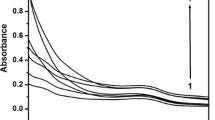Abstract
Understanding the mechanisms of mutual recognition and complementary binding of molecules in guest-host complexes is based on analysis of their spatial structure. As guest-host complexes, we have synthesized inclusion compounds of 1,4-benzodiazepine anxiolytic agents gidazepam and cinazepam with β-cyclodextrin, in which these anxiolytic agents manifest increased biological accessibility. The spatial structure of the complexes was determined from the two-dimensional NOESY spectra and analysis of the fragmentary mobility of the guest and host molecules, characterized by spin-lattice relaxation times T1 of the13C nuclei. An analysis of d-contacts showed that the 5-phenyl ring is completely enclosed in the inner hydrophobic cavity of β-CD [(C2′ H-C4′ H)-CIIH(CIVH), CVH (CIIIH, CVIH2), CVIOH]. For the 1:1 complex, intense d-contracts of C8H with CVIOH indicate that C8H is located in the vicinity of both wide and narrow bases of the bracelet. This is only possible for the 2:2 complex, in which both β-CD molecules approach each other by their wide and narrow bases. A comparison between the schemes of d-contacts for the 2:2 and 2:1 associates proves that the β-CD molecules have the same spatial orientation in the dimer. The difference is in the fact that the hydrazinocarbonyl fragment of gidazepam and the hemisuccinate fragment of cinazepam penetrate into an empty molecule of the 2:1 β-CD complex (NH2-CIH contact). The intensities of the cross peaks were measured, due to which the interatomic distances between the guest and host molecules were calculated and the spatial structure of the clathrates was established. The benzodiazepine derivatives are embedded differently into the clathrate molecule, as shown by the value of the angle between the symmetry axis of β-CD and the axis through the centers of the aromatic rings: 0° for gidazepam and 60° for cinazepam. This is a consequence of the fact that the substituents forming hydrogen bonds with hydroxyl groups at the wide base of the β-CD bracelet lie in different positions: the hydrazinocarbonylmethyl fragment of gidazepam lies at N1, and the hemisuccinate fragment of cinazepam is at C3.
Similar content being viewed by others
References
Host Guest Complexes Chemistry, F. Vögtle and E. Weber (eds.), Springer, New York (1985).
J.-M. Lehn, in:Biomimetic Chemistry. Studies in Organic Chemistry, Vol. 13, Z. Yoshida and N. Isc (eds.), Elsevier, Amsterdam (1983), p. 163.
R. Breslow,ibid., Z. Yoshida and N. Isc (eds.), Elsevier, Amsterdam (1983), p. 1.
V. T. D'Soura and M. L. Bender,Acc. Chem. Res.,20, 146 (1987).
Yu. Sh. Goldberg,Selected Sections of Phase Transfer Catalysis [in Russian], Zinatne, Riga (1989).
V. G. Belikov, E. V. Kompantseva, and Yu. K. Botezat-Belyi,Khim.-Farm. Zh., No. 5, 525–532 (1986).
J. Szejtli,Cyclodextrins and Their Inclusion Complexes, Budapest (1982).
E. V. Sevastianova, T. I. Davidenko, Yu. E. Shapiro, and E. G. Pykhteeva,Dokl. Akad. Nauk Ukr.: Matem., Estestvozn., Tekhn. Nauki, No. 7, 110–115 (1993).
Yu. E. Shapiro, V. Ya. Gorbatyuk, V. M. Kabanov, et al.,Bioorg. Khim.,16, No. 12, 1607–1617 (1990).
Yu. E. Shapiro, V. Ya. Gorbatyuk, A. A. Mazurov, and S. A. Andronati,The Analyst,119, No. 4, 647–652 (1994).
H. Schütz,Benzodiazepines II. A Handbook, Springer, Berlin (1989).
S. A. Andronati, T. A. Voronina, N. Ya. Golovenko, et al.,Gidazepam [in Russian], Naukova Dumka, Kiev (1992).
V. Ya. Gorbatyuk, Yu. E. Shapiro, L. N. Yakubovskaya, and S. A. Andronati,Khim-Farm. Zh., No. 6, 50–56 (1996).
B. G. Zykov, O. G. Khvostenko, V. I. Khvostenko, et al.,Izv. Ross. Akad. Nauk, Ser. Khim., No. 9, 1583–1587 (1993).
Yu. Goldberg, É. Abele, K. Rubina, et al.,Khim. Geterotsikl. Soedin, No. 12, 1621–1627 (1993).
C. J. Hartzell, S. R. Mente, N. L. Eastman, and J. L. Beckett,J. Phys. Chem.,97 No. 19, 4887–4890 (1993).
J. L. Beckett, C. J. Hartzell, N. L. Eastman, et al.,J. Org. Chem.,57, No. 15, 4173–4179 (1992).
V. S. Kartashov, S. V. Shorshnev, and A. P. Arzamastsev,Khim.-Farm. Zh., No. 10, 78–80 (1991).
L. P. Lindeman and J. Q. Adams,Anal. Chem.,43, No. 7, 1245–1252 (1971).
R. R. Ernst, G. Bodenhausen, and A. Wokaun,Principles of Nuclear Magnetic Resonance in One and Two Dimensions, Clarendon, Oxford (1987).
M. R. Bendall and D. T. Pegg,J. Magn. Res.,53, No. 1, 144–149 (1983).
Additional information
A. V. Bogatskii Physicochemical Institute, Ukrainian National Academy of Sciences. Translated fromZhurnal Strukturnoi Khimii, Vol. 37, No. 5, pp. 876–890, September–October, 1996.
Translated by L. Smolina
Rights and permissions
About this article
Cite this article
Shapiro, Y.E., Gorbatyuk, V.Y., Yakubovskaya, L.N. et al. Spatial structure of β-cyclodextrin clathrates with 1,4-benzodiazepine derivatives. J Struct Chem 37, 747–758 (1996). https://doi.org/10.1007/BF02437036
Received:
Issue Date:
DOI: https://doi.org/10.1007/BF02437036




